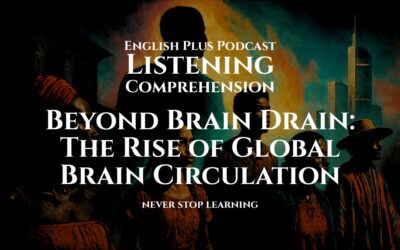Introduction to Listening & Listening Tips
Greetings, aspiring global citizens and exam preparers! Today, we’re diving into the bedrock principles of economics: supply and demand. These two forces are fundamental to understanding how markets function, from your local grocery store to the complexities of international trade. For your international exams, comprehending such core concepts is vital, not just for specific economics questions, but also for interpreting wider passages on global affairs.
To excel in listening comprehension, particularly with academic topics like economics, consider these strategies:
- Activate Prior Knowledge: Before the audio begins, what do you already know about supply and demand? Even a basic understanding can help you organize the incoming information.
- Listen for Definitions and Examples: Academic lectures often define key terms and then illustrate them with examples. Pay close attention when the speaker introduces a new concept or elaborates on one.
- Identify Relationships: Economics often deals with cause-and-effect relationships. As you listen, try to mentally map out how one factor influences another (e.g., how a change in price affects demand).
- Differentiate Opinions from Facts: The speaker might present widely accepted economic principles (facts) and also discuss different economic perspectives or interpretations (opinions). Learn to distinguish between them.
- Visualize: If the speaker describes a market, try to visualize it. Imagine buyers, sellers, prices, and quantities. This can help solidify abstract concepts.
- Don’t Get Stuck on One Word: If you miss a word or phrase, don’t dwell on it. Keep listening for the overall meaning. Often, the context will clarify or you can infer its meaning from later information.
Let’s explore the foundational dance of supply and demand that orchestrates our global economic landscape.
Focus on Listening
Listening Comprehension Quiz
Listening Transcript
Listening Transcript: Please don’t read the transcript before you listen and take the quiz.
Good morning, everyone. Today, we embark on a journey into the very heart of economic theory: the principles of supply and demand. These aren’t just abstract concepts for economists; they are the invisible hand, as Adam Smith famously put it, that guides virtually every transaction, every market, and every price we encounter in the global economy. Understanding their interplay is absolutely foundational to comprehending how resources are allocated, how prices are determined, and why markets behave the way they do.
Let’s begin with demand. In economics, demand refers to the quantity of a good or service that consumers are willing and able to purchase at various prices during a given2 period. It’s crucial to note that “willing and able” is key; desire alone isn’t enough. There’s a fundamental principle known as the Law of Demand, which states that, all else being equal, as the price of a good or service increases, the quantity demanded decreases, and vice versa. Think about it intuitively: if the price of your favorite coffee suddenly doubles, you’re likely to buy less of it, or perhaps none at all. Conversely, if it halves, you might be inclined to buy more. This inverse relationship between price and quantity demanded is often depicted as a downward-sloping demand curve on a graph.
Now, what influences demand beyond price? Several factors, known as demand determinants, can shift the entire demand curve. These include consumer income (as incomes rise, demand for normal goods often increases), consumer tastes and preferences (a popular new trend can boost demand), the price of related goods (substitutes and complements), consumer expectations about future prices, and the size of the market (more consumers mean more demand). For instance, if news breaks that a particular brand of smartphone is going to have a significant price drop next month, current demand for that phone might decrease as consumers delay their purchases, anticipating the lower price. This represents a shift of the demand curve, not just movement along it.
Next, let’s turn our attention to supply. Supply refers to the quantity of a good or service that producers are willing and able to offer for sale at various prices during3 a given period. Just like demand, “willing and able” applies here too. The Law of Supply states that, all else being equal, as the price of a good or service increases, the quantity supplied increases, and vice versa.4 Why? Because higher prices offer producers a greater incentive to produce more, potentially leading to higher profits. If the price of wheat goes up, farmers will be encouraged to plant more wheat. This direct relationship between price and quantity supplied is represented by an upward-sloping supply curve.
Similar to demand, several factors, called supply determinants, can shift the entire supply curve. These include the cost of inputs (raw materials, labor – if these costs rise, supply tends to decrease), technology (improvements in technology can increase efficiency and thus supply), government policies (taxes or subsidies can affect production costs), the number of sellers in the market, and producers’ expectations about future prices. For example, if a new, more efficient automated manufacturing process is developed for cars, car producers can make more cars at a lower cost, increasing the overall supply of cars at every price level. This is a shift of the supply curve.
The magic truly happens when supply and demand interact in a market. The point where the quantity demanded equals the quantity supplied is known as the equilibrium point, and the corresponding price is the equilibrium price, also sometimes called the market-clearing price. At this price, there’s no surplus (excess supply) or shortage (excess demand). The market is “cleared.”
Imagine a simple scenario: a new smartphone is launched. Initially, the price might be set high. At this high price, the quantity supplied might exceed the quantity demanded, leading to a surplus. What happens? Producers will likely lower the price to sell off the excess. As the price falls, quantity demanded increases, and quantity supplied decreases, moving towards equilibrium. Conversely, if the price is set too low, quantity demanded might exceed quantity supplied, creating a shortage. Consumers might face long waits or products selling out quickly. In response, producers might raise the price, incentivized by higher profits, while some consumers drop out, moving the market back towards equilibrium. This constant adjustment is the market mechanism at work.
Global markets add another layer of complexity to this fundamental interaction. Trade agreements, tariffs, exchange rates, and geopolitical events all influence the global supply and demand curves for various goods and services. For instance, a trade war, as we discussed previously, involves tariffs that effectively increase the cost of imported goods, shifting the supply curve inward for those goods in the importing country, leading to higher prices and lower quantities. Conversely, a technological breakthrough in one country can dramatically increase global supply, potentially lowering prices worldwide.
In conclusion, while numerous variables can influence market outcomes, the twin forces of supply and demand remain the bedrock of economic analysis. Grasping their individual laws, their determinants, and their dynamic interaction is paramount to understanding not just individual markets but also the intricate web of the global economy. This foundational knowledge will serve you well in any advanced study of economics or international relations. Thank you.
Keywords and Phrases
- Bedrock principles: This refers to the most fundamental, essential, or basic principles upon which everything else is built. Just like bedrock is the solid rock layer beneath the surface of the earth, these are the core ideas of economics. The speaker uses it to emphasize the foundational importance of supply and demand.
- Invisible hand: This is a famous metaphor coined by economist Adam Smith. It describes the unseen forces that move the free market economy. It suggests that individuals pursuing their own self-interest can unintentionally benefit society as a whole. The speaker uses it to explain how supply and demand naturally guide market transactions.
- Interplay is absolutely foundational: “Interplay” means the way in which two or more things influence each other. “Foundational” means serving as a base or foundation. So, the “interplay” of supply and demand is “foundational” because their interaction is the essential basis for understanding how markets work.
- Quantity of a good or service that consumers are willing and able to purchase: This is a crucial economic definition of “demand.” “Willing” means they want it, and “able” means they have the money to buy it. Both conditions must be met for demand to exist in an economic sense.
- All else being equal (ceteris paribus): This Latin phrase is a very common assumption in economics, meaning “all other things remaining constant.” When economists state a law (like the Law of Demand), they assume that only the variables they are discussing are changing, while all other influencing factors are held steady.
- Inverse relationship: This means that when one factor increases, the other factor decreases, and vice versa. The Law of Demand describes an “inverse relationship” between price and quantity demanded: as price goes up, demand goes down.
- Downward-sloping demand curve: In economics, graphs are often used. A “downward-sloping demand curve” is a visual representation where the line goes down from left to right, illustrating the inverse relationship between price and quantity demanded.
- Demand determinants: These are the various non-price factors that can cause the entire demand curve to shift. They “determine” the overall level of demand at any given price. Examples include income, tastes, and prices of related goods.
- Shift the entire demand curve: This means that at every single price point, consumers are now willing to buy either more or less of a product. It’s different from just moving along an existing curve (which happens when only price changes). A “shift” indicates a change in the fundamental conditions of demand.
- Upward-sloping supply curve: Similar to the demand curve, an “upward-sloping supply curve” on a graph shows that as the price of a good increases, producers are willing to supply more of it, representing a direct relationship.
- Cost of inputs: These are the expenses incurred by producers to create a good or service. This includes raw materials, labor wages, energy costs, etc. If the “cost of inputs” rises, it generally becomes more expensive to produce, which affects supply.
- Equilibrium point / equilibrium price / market-clearing price: This is the ideal state in a market where the quantity of a product that consumers want to buy exactly matches the quantity that producers are willing to sell. The “equilibrium price” is the specific price at which this balance occurs, and it’s also called the “market-clearing price” because there’s no surplus or shortage.
- Surplus (excess supply): A “surplus” occurs when producers supply more of a product than consumers are demanding at a given price. There’s an “excess supply” of goods sitting unsold.
- Shortage (excess demand): A “shortage” occurs when consumers demand more of a product than producers are supplying at a given price. There’s an “excess demand,” and products sell out quickly.
- Intricate web of the global economy: This is a metaphorical phrase describing the complex and interconnected nature of the world’s economic systems. Like a spider’s web, everything is linked, and a disturbance in one part can affect many others. It highlights the vast and interconnected nature of global trade and finance.










0 Comments